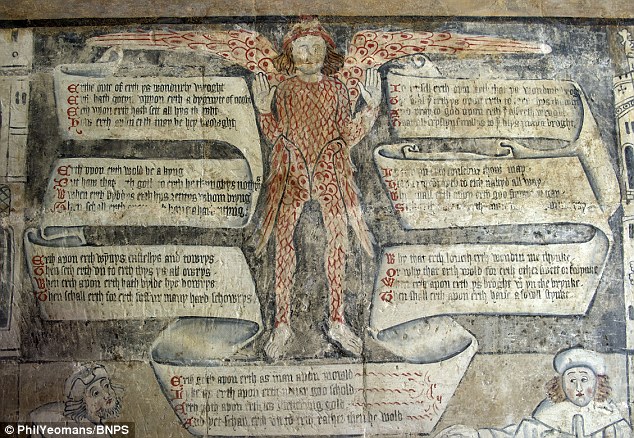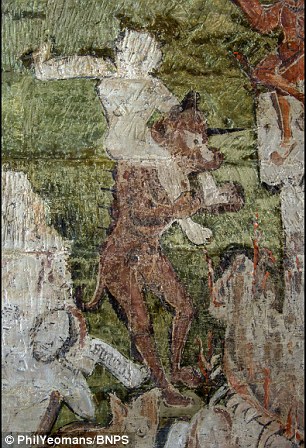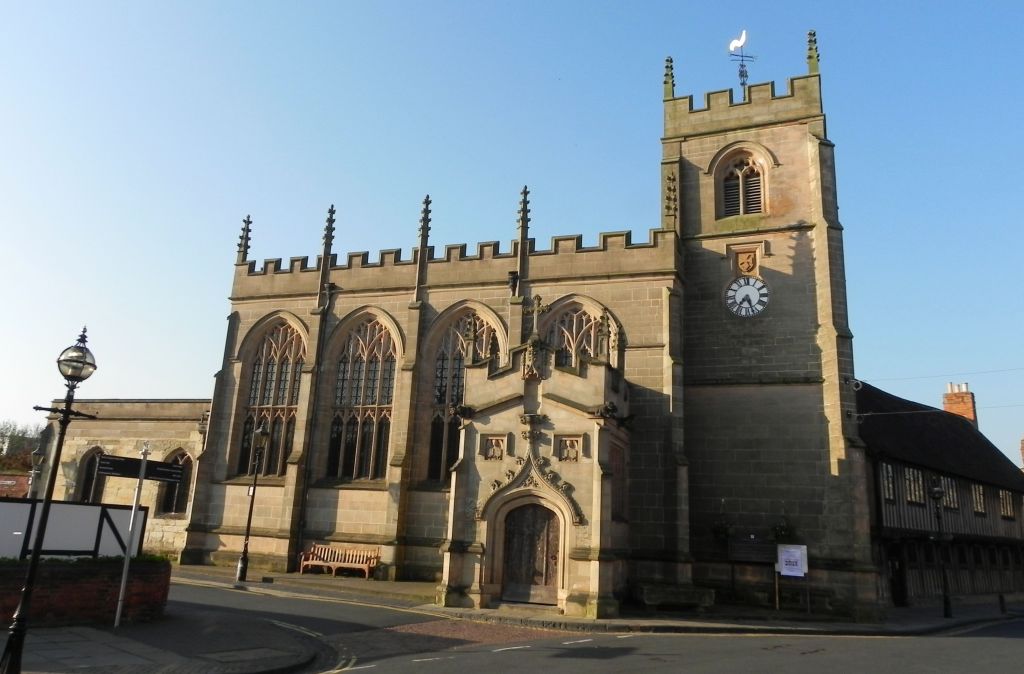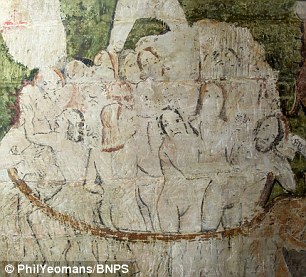Incredible medieval church murals not seen since the 16th century have been restored as part of a painstaking preservation project.
The murals were covered after William Shakespeare's father was ordered to paint over them more than 450 years ago.
The colourful murals, thought to be some of the finest in Europe, were covered with limewash in 1563 when John Shakespeare was bailiff of Stratford-upon-Avon.
He was acting on orders as part of the Protestant Reformation which was a backlash against the Catholic Church...
Stunning medieval murals painted over by Shakespeare's father are revealed for the first time in 450 years
They were covered in 1563 by the Bard's father, John Shakespeare
It is thought John Shakespeare's careful use of limewash in Stratford-upon-Avon's Guild Chapel showed a reluctance by him to destroy the art altogether
By Libby Plummer For Mailonline
23 November 2016
Incredible medieval church murals not seen since the 16th century have been restored as part of a painstaking preservation project.
The murals were covered after William Shakespeare's father was ordered to paint over them more than 450 years ago.
The colourful murals, thought to be some of the finest in Europe, were covered with limewash in 1563 when John Shakespeare was bailiff of Stratford-upon-Avon.

The colourful murals, thought to be some of the finest in Europe, were covered with limewash in 1563 when John Shakespeare was bailiff of Stratford-Upon-Avon. A close-up shows the Angel Gabriel with allegory written in English from the restored 'Allegory of Death' mural
He was acting on orders as part of the Protestant Reformation which was a backlash against the Catholic Church.
The 16th century Reformation, championed by reformers including Henry VIII and Augustinian monk Martin Luther, saw a huge upheaval in the religion, politics and culture of the day, triggering persecutions and conflicts.
The movement involved widespread rejection of Catholic art, much of which was destroyed.
It is thought John Shakespeare's careful use of limewash in Stratford's Guild Chapel showed a reluctance by him to destroy the beautiful art altogether, a fate which befell similar paintings in churches across the country.


Pictured are details from the restored 'Allegory of Death' mural. Work to reveal, clean and retouch this painting will be completed at the end of the month

John Shakespeare was reluctantly acting upon orders as part of the Protestant Reformation which was a backlash against the Catholic Church. Pictured is close-up from the restored 'Allegory of Death' mural
Now a £100,000 ($124,000) project to uncover the elaborate wall paintings - which have been hidden away for hundreds of years - is about to be completed.
One of the murals shows an angel ascending to heaven while another depicts the devil wielding a club.


Strange creatures, including a colourful devil, torment the sinners in hell in one of the restored murals. Conservators believe the church is one of only a handful of places in Europe to have an almost complete medieval decorative scheme still in situ

The Guild Chapel in Stratford-upon-Avon, Warwickshire

William Shakespeare was born in 1564, a year after the murals were covered up.
Conservators believe the church is one of only a handful of places in Europe to have an almost complete medieval decorative scheme still in situ.
Cate Statham, project manager for conservation architects Hawkes, Edwards and Cave which has been working in the restoration, said: 'With the Reformation, there was a decree from above that worship had become too iconoclastic - there were too many images and churches had become very decorative.
'This church went from being very colourful and vibrant, with images of angels, to being much more puritan.
'We believe that while they were doing some work on the church in 1804 they uncovered paintings, but they obviously didn't think they were important so they covered them up again.
'We knew about the presence of something behind the panelling on the north and south walls but the level of detail retained on the south wall in particular is really exciting and encouraging.

The fully restored 'Allegory of Death' mural at Stratford's Guild Chapel is pictured. Cate Statham, project manager for conservation, said: 'With the Reformation, there was a decree from above that worship had become too iconoclastic'

Trevor Edwards, head conservator on the restoration project, stands in front of the restored 'Allegory of Death' mural

William Shakespeare was born in 1564, a year after the murals were covered up. Pictured is a close-up from the restored 'Allegory of Death' mural
'The Guild Chapel's earlier interior scheme was colourful, vibrant and decorative, with every single wall covered in paintings.
'We are very fortunate to have what represents an almost complete pre-Reformation medieval scheme still in situ, where the design was conceived and executed all as one piece of work at the same time - and we know of only a few comparable examples surviving in all of Europe.'
Work to reveal, clean and retouch two of the best-preserved wall paintings within the chapel - the Doom and Allegory of Death - will be completed at the end of the month.

John Shakespeare, the father of William Shakespeare (pictured), was reluctantly acting upon orders

The colourful murals at Guild Chapel, thought to be some of the finest in Europe, were covered with limewash in 1563 when John Shakespeare was bailiff of Stratford-Upon-Avon


Mural details showing a tormented sinner in hell and chained sinners descending into hell on the Day of Judgement

The removal of Victorian wood panelling revealed even more murals.William Shakespeare's father John, who was bailiff of Stratford, was ordered to destroy the colourful murals in 1563 during the Reformation
The Allegory of Death - which measures 6.5 feet by 5 feet and reflects on death, the immortality of the soul and the afterlife - is now completely visible for the first time since the 16th century.
Mrs Statham said: 'It is an exceptional survival. Although there are others, to our knowledge none of them are as complete or in as good condition, making it incredibly rare.
'The last time it was viewed as it is now was most likely to have been in the 16th century, before it was limewashed, before another scheme was painted over the top, before the high level gallery, and then the late timber panelling were installed.
'The fact that it survived through the centuries to stand in this condition today is quite remarkable.'


A restored mural shows the saved emerging from their graves on the Day of Judgement amid flower filled fields. The ancient paintings painstakingly were restored by conservators

The medieval church murals not seen the 16th century have been restored as part of painstaking preservation project by conservation architects Hawkes, Edwards and Cave

A conservator at work restoring a depiction of an angel on one of the medieval murals
Trevor Edwards, of Hawkes, Edwards and Cave, said: 'We knew the paintings were there - they have been uncovered twice.
'What we didn't know was the condition of the paintings and whether we would be able to do anything with them.
'What we have found is, with modern conservation techniques, we can restore them.
'What makes them so important is that it's all still there, which makes it a lot more like surviving paintings in churches on the continent.'
Medieval murals painted over by Shakespeare's father revealed for first time in 450 years | Daily Mail Online
The murals were covered after William Shakespeare's father was ordered to paint over them more than 450 years ago.
The colourful murals, thought to be some of the finest in Europe, were covered with limewash in 1563 when John Shakespeare was bailiff of Stratford-upon-Avon.
He was acting on orders as part of the Protestant Reformation which was a backlash against the Catholic Church...
Stunning medieval murals painted over by Shakespeare's father are revealed for the first time in 450 years
They were covered in 1563 by the Bard's father, John Shakespeare
It is thought John Shakespeare's careful use of limewash in Stratford-upon-Avon's Guild Chapel showed a reluctance by him to destroy the art altogether
By Libby Plummer For Mailonline
23 November 2016
Incredible medieval church murals not seen since the 16th century have been restored as part of a painstaking preservation project.
The murals were covered after William Shakespeare's father was ordered to paint over them more than 450 years ago.
The colourful murals, thought to be some of the finest in Europe, were covered with limewash in 1563 when John Shakespeare was bailiff of Stratford-upon-Avon.

The colourful murals, thought to be some of the finest in Europe, were covered with limewash in 1563 when John Shakespeare was bailiff of Stratford-Upon-Avon. A close-up shows the Angel Gabriel with allegory written in English from the restored 'Allegory of Death' mural
He was acting on orders as part of the Protestant Reformation which was a backlash against the Catholic Church.
The 16th century Reformation, championed by reformers including Henry VIII and Augustinian monk Martin Luther, saw a huge upheaval in the religion, politics and culture of the day, triggering persecutions and conflicts.
The movement involved widespread rejection of Catholic art, much of which was destroyed.
It is thought John Shakespeare's careful use of limewash in Stratford's Guild Chapel showed a reluctance by him to destroy the beautiful art altogether, a fate which befell similar paintings in churches across the country.


Pictured are details from the restored 'Allegory of Death' mural. Work to reveal, clean and retouch this painting will be completed at the end of the month

John Shakespeare was reluctantly acting upon orders as part of the Protestant Reformation which was a backlash against the Catholic Church. Pictured is close-up from the restored 'Allegory of Death' mural
Now a £100,000 ($124,000) project to uncover the elaborate wall paintings - which have been hidden away for hundreds of years - is about to be completed.
One of the murals shows an angel ascending to heaven while another depicts the devil wielding a club.


Strange creatures, including a colourful devil, torment the sinners in hell in one of the restored murals. Conservators believe the church is one of only a handful of places in Europe to have an almost complete medieval decorative scheme still in situ

The Guild Chapel in Stratford-upon-Avon, Warwickshire

William Shakespeare was born in 1564, a year after the murals were covered up.
Conservators believe the church is one of only a handful of places in Europe to have an almost complete medieval decorative scheme still in situ.
Cate Statham, project manager for conservation architects Hawkes, Edwards and Cave which has been working in the restoration, said: 'With the Reformation, there was a decree from above that worship had become too iconoclastic - there were too many images and churches had become very decorative.
'This church went from being very colourful and vibrant, with images of angels, to being much more puritan.
'We believe that while they were doing some work on the church in 1804 they uncovered paintings, but they obviously didn't think they were important so they covered them up again.
'We knew about the presence of something behind the panelling on the north and south walls but the level of detail retained on the south wall in particular is really exciting and encouraging.

The fully restored 'Allegory of Death' mural at Stratford's Guild Chapel is pictured. Cate Statham, project manager for conservation, said: 'With the Reformation, there was a decree from above that worship had become too iconoclastic'

Trevor Edwards, head conservator on the restoration project, stands in front of the restored 'Allegory of Death' mural

William Shakespeare was born in 1564, a year after the murals were covered up. Pictured is a close-up from the restored 'Allegory of Death' mural
'The Guild Chapel's earlier interior scheme was colourful, vibrant and decorative, with every single wall covered in paintings.
'We are very fortunate to have what represents an almost complete pre-Reformation medieval scheme still in situ, where the design was conceived and executed all as one piece of work at the same time - and we know of only a few comparable examples surviving in all of Europe.'
Work to reveal, clean and retouch two of the best-preserved wall paintings within the chapel - the Doom and Allegory of Death - will be completed at the end of the month.

John Shakespeare, the father of William Shakespeare (pictured), was reluctantly acting upon orders

The colourful murals at Guild Chapel, thought to be some of the finest in Europe, were covered with limewash in 1563 when John Shakespeare was bailiff of Stratford-Upon-Avon


Mural details showing a tormented sinner in hell and chained sinners descending into hell on the Day of Judgement

The removal of Victorian wood panelling revealed even more murals.William Shakespeare's father John, who was bailiff of Stratford, was ordered to destroy the colourful murals in 1563 during the Reformation
The Allegory of Death - which measures 6.5 feet by 5 feet and reflects on death, the immortality of the soul and the afterlife - is now completely visible for the first time since the 16th century.
Mrs Statham said: 'It is an exceptional survival. Although there are others, to our knowledge none of them are as complete or in as good condition, making it incredibly rare.
'The last time it was viewed as it is now was most likely to have been in the 16th century, before it was limewashed, before another scheme was painted over the top, before the high level gallery, and then the late timber panelling were installed.
'The fact that it survived through the centuries to stand in this condition today is quite remarkable.'


A restored mural shows the saved emerging from their graves on the Day of Judgement amid flower filled fields. The ancient paintings painstakingly were restored by conservators

The medieval church murals not seen the 16th century have been restored as part of painstaking preservation project by conservation architects Hawkes, Edwards and Cave

A conservator at work restoring a depiction of an angel on one of the medieval murals
Trevor Edwards, of Hawkes, Edwards and Cave, said: 'We knew the paintings were there - they have been uncovered twice.
'What we didn't know was the condition of the paintings and whether we would be able to do anything with them.
'What we have found is, with modern conservation techniques, we can restore them.
'What makes them so important is that it's all still there, which makes it a lot more like surviving paintings in churches on the continent.'
Medieval murals painted over by Shakespeare's father revealed for first time in 450 years | Daily Mail Online
Last edited: